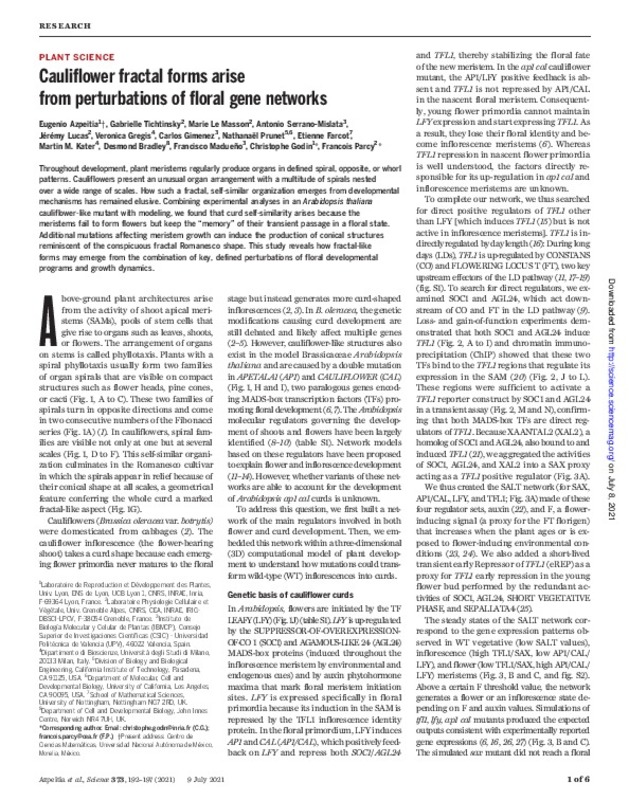Azpeitia, E.; Tichtinsky, G.; Le Masson, M.; Serrano-Mislata, A.; Lucas, J.; Gregis, V.; Gimenez, C.... (2021). Cauliflower fractal forms arise from perturbations of floral gene networks. Science. 373(6551):1-6. https://doi.org/10.1126/science.abg5999
Por favor, use este identificador para citar o enlazar este ítem: http://hdl.handle.net/10251/182273
|
Título:
|
Cauliflower fractal forms arise from perturbations of floral gene networks
|
|
Autor:
|
Azpeitia, Eugenio
Tichtinsky, Gabrielle
Le Masson, Marie

 Serrano-Mislata, Antonio
Lucas, Jeremy
Gregis, Veronica
Gimenez, Carlos
Prunet, Natanael
Farcot, Etienne
Kater, Martin M.
Bradley, Desmond
Serrano-Mislata, Antonio
Lucas, Jeremy
Gregis, Veronica
Gimenez, Carlos
Prunet, Natanael
Farcot, Etienne
Kater, Martin M.
Bradley, Desmond
 MADUEÑO ALBI, FRANCISCO
Godin, Christophe
Parcy, Francois
MADUEÑO ALBI, FRANCISCO
Godin, Christophe
Parcy, Francois
|
|
Entidad UPV:
|
Universitat Politècnica de València. Instituto Universitario Mixto de Biología Molecular y Celular de Plantas - Institut Universitari Mixt de Biologia Molecular i Cel·lular de Plantes
|
|
Fecha difusión:
|
|
|
Resumen:
|
[EN] Throughout development, plant meristems regularly produce organs in defined spiral, opposite, or whorl patterns. Cauliflowers present an unusual organ arrangement with a multitude of spirals nested over a wide range ...[+]
[EN] Throughout development, plant meristems regularly produce organs in defined spiral, opposite, or whorl patterns. Cauliflowers present an unusual organ arrangement with a multitude of spirals nested over a wide range of scales. How such a fractal, self-similar organization emerges from developmental mechanisms has remained elusive. Combining experimental analyses in an Arabidopsis thaliana cauliflower-like mutant with modeling, we found that curd self-similarity arises because the meristems fail to form flowers but keep the "memory" of their transient passage in a floral state. Additional mutations affecting meristem growth can induce the production of conical structures reminiscent of the conspicuous fractal Romanesco shape. This study reveals how fractal-like forms may emerge from the combination of key, defined perturbations of floral developmental programs and growth dynamics.
[-]
|
|
Derechos de uso:
|
Reserva de todos los derechos
|
|
Fuente:
|
Science. (issn:
0036-8075
)
|
|
DOI:
|
10.1126/science.abg5999
|
|
Editorial:
|
American Association for the Advancement of Science (AAAS)
|
|
Versión del editor:
|
https://doi.org/10.1126/science.abg5999
|
|
Código del Proyecto:
|
info:eu-repo/grantAgreement/AEI/Plan Estatal de Investigación Científica y Técnica y de Innovación 2017-2020/PGC2018-099232-B-I00/ES/DESCIFRANDO EL MODO DE ACCION DE TERMINAL FLOWER 1/
info:eu-repo/grantAgreement/ANR//ANR-10-LABX-49-01/
info:eu-repo/grantAgreement/EC/H2020/773875/EU
info:eu-repo/grantAgreement/ANR//ANR-17-EURE-0003/
|
|
Agradecimientos:
|
This work was supported by the INRAE Caulimodel project (to F.P. and C.Go.); Inria Project Lab Morphogenetics (to C.Go., E.A., and F.P.); the ANR BBSRC Flower model project (to F.P. and C.Go.); the GRAL LabEX (ANR-10-LABX-49-01) ...[+]
This work was supported by the INRAE Caulimodel project (to F.P. and C.Go.); Inria Project Lab Morphogenetics (to C.Go., E.A., and F.P.); the ANR BBSRC Flower model project (to F.P. and C.Go.); the GRAL LabEX (ANR-10-LABX-49-01) within the framework of the CBH-EUR-GS (ANR-17-EURE-0003) (to F.P., G.T., M.L.M., and J.L.); the EU H2020 773875 ROMI project (to C.Go.); and the Spanish Ministerio de Ciencia Innovacion and FEDER (grant no. PGC2018-099232-B-I00 to F.M.).
[-]
|
|
Tipo:
|
Artículo
|









